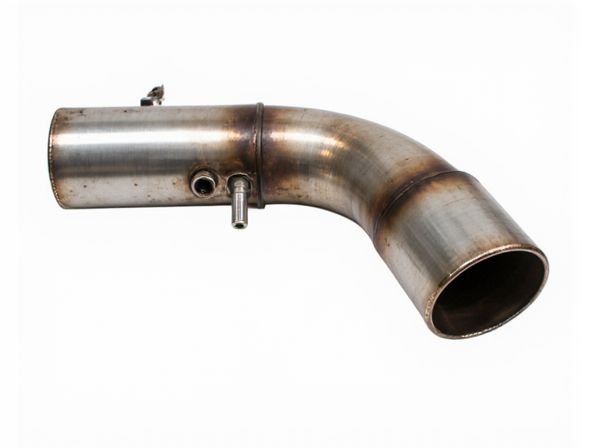
Photo illustration: Mandrel Bend vs Crush Bend
Mandrel bends maintain the tube's shape and diameter during bending, ensuring smooth, wrinkle-free curves ideal for exhaust systems and custom piping. Crush bends deform the tube's cross-section, causing flattening and potential flow restriction, which can reduce efficiency in fluid or gas movement. Choose mandrel bends for precision and performance, while crush bends may suffice for simpler, less critical applications.
Table of Comparison
| Feature | Mandrel Bend | Crush Bend |
|---|---|---|
| Bend Quality | Smooth, consistent diameter, minimal deformation | Flattened, uneven diameter, potential restrictions |
| Exhaust Flow | Optimal, maintains pipe cross-section, reduces backpressure | Restricted, reduced cross-section increases backpressure |
| Performance Impact | Improves horsepower and torque | May decrease engine efficiency |
| Durability | High, less stress and cracking | Lower, prone to cracks and fatigue |
| Cost | Higher due to advanced bending process | Lower, simpler manufacturing |
| Best Use | Performance exhaust systems, custom setups | Budget or OEM exhausts with tight space |
Introduction to Mandrel Bend and Crush Bend
Mandrel bends maintain pipe diameter by using a removable mandrel inserted inside the pipe during bending, preventing collapse and deformation, making them ideal for precise and smooth, uniform bends in tubing or conduit. Crush bends occur when the pipe is bent without internal support, causing the pipe to flatten, distort, or ovalize, which can reduce flow capacity and structural integrity. Understanding the difference between mandrel bend and crush bend is crucial for applications requiring consistent pipe dimensions and strength, such as hydraulic systems and automotive exhausts.
Understanding Pipe Bending Processes
Mandrel bend involves inserting a solid or flexible mandrel inside the pipe to prevent collapse and maintain the pipe's internal diameter, making it ideal for tight-radius bends and thin-walled tubing. Crush bend occurs when the pipe is bent without internal support, often resulting in deformation, flattening, or wrinkling, which can compromise structural integrity and fluid flow. Understanding these processes is critical for selecting the appropriate bending technique based on material type, pipe thickness, and application-specific requirements.
What Is Mandrel Bending?
Mandrel bending is a precise tube bending technique that uses a flexible mandrel inserted inside the tube to prevent deformation and maintain a consistent diameter during tight radius bends. This method ensures smooth, wrinkle-free curves without flattening or crushing the tube, which is essential for applications requiring high structural integrity and aesthetics, such as automotive exhaust systems and aerospace components. Compared to crush bending, mandrel bending delivers superior accuracy and strength by preserving the tube's original cross-sectional shape throughout the bend.
What Is Crush Bending?
Crush bending is a metal forming process that involves physically compressing a tube or pipe with a die to create a bend, often resulting in a flattened or deformed section. Unlike mandrel bending, which uses a mandrel inserted inside the tube to maintain its shape and prevent wrinkling, crush bending typically sacrifices internal tube integrity for sharper or more compact bends. This method is commonly used when tight bend radii are required without concern for internal deformation or if the pipe's appearance and flow characteristics are less critical.
Key Differences Between Mandrel and Crush Bends
Mandrel bends maintain a consistent tube diameter and smooth curvature by using a solid mandrel inside the tube during bending, minimizing deformation and wrinkles, which is crucial for high-performance exhaust systems and hydraulic tubing. Crush bends, on the other hand, typically involve bending without internal support, causing the tube to collapse or flatten, resulting in inconsistent flow and potential structural weaknesses. Mandrel bends are preferred for precision applications requiring optimal flow efficiency and structural integrity, whereas crush bends are more cost-effective but less reliable for high-stress environments.
Performance Impact: Mandrel vs. Crush Bend
Mandrel bends maintain consistent pipe diameter and shape, ensuring smooth fluid flow and minimizing pressure drops, which significantly enhances performance in high-flow systems. Crush bends deform the pipe's cross-section, causing increased turbulence and reduced flow efficiency, leading to higher energy consumption and potential system wear. Choosing mandrel bends over crush bends is critical for applications requiring optimal flow dynamics and long-term durability.
Durability and Strength Comparison
Mandrel bends maintain consistent pipe diameter without wrinkles, preserving structural integrity and ensuring maximum durability and strength, especially in high-pressure applications. Crush bends often cause deformation and wall thinning, leading to potential weak points and reduced lifespan under stress. Selecting mandrel bends enhances overall performance by minimizing stress concentrations and increasing resistance to fatigue and cracking.
Application Suitability: When to Use Each Method
Mandrel bends are ideal for applications requiring precise, smooth pipe curves without deformation, such as automotive exhaust systems and high-performance fluid transfer lines. Crush bends suit structural or low-pressure applications where slight deformation is acceptable, like certain HVAC ductwork or structural tubing. Selecting between mandrel and crush bending depends on the necessity for maintaining pipe integrity and flow characteristics under operational conditions.
Cost Considerations in Pipe Bending
Mandrel bend pipe bending involves using a flexible mandrel inserted into the pipe to prevent wrinkling and maintain a smooth radius, resulting in higher upfront costs due to specialized equipment and skilled labor. Crush bend methods typically incur lower initial costs as they rely on external force to bend the pipe without internal support, but they risk deforming the pipe cross-section, potentially leading to increased maintenance or replacement expenses. Choosing between mandrel and crush bends requires balancing immediate cost savings against long-term durability and performance needs in piping systems.
Choosing the Right Bending Method for Your Project
Mandrel bends maintain pipe diameter and prevent deformation, making them ideal for projects requiring precise flow and minimal pressure loss. Crush bends, which flatten the pipe during bending, are suitable for applications with tight space constraints but can reduce flow efficiency and structural integrity. Choosing the right bending method depends on project priorities like maintaining pipe integrity versus conforming to space limitations.
 caratoz.com
caratoz.com